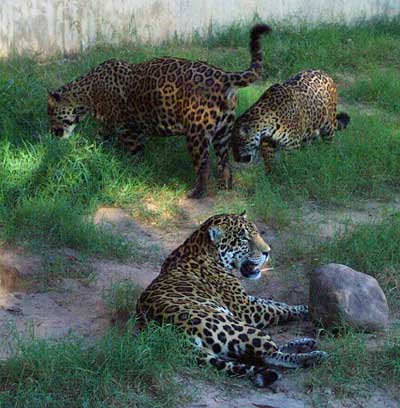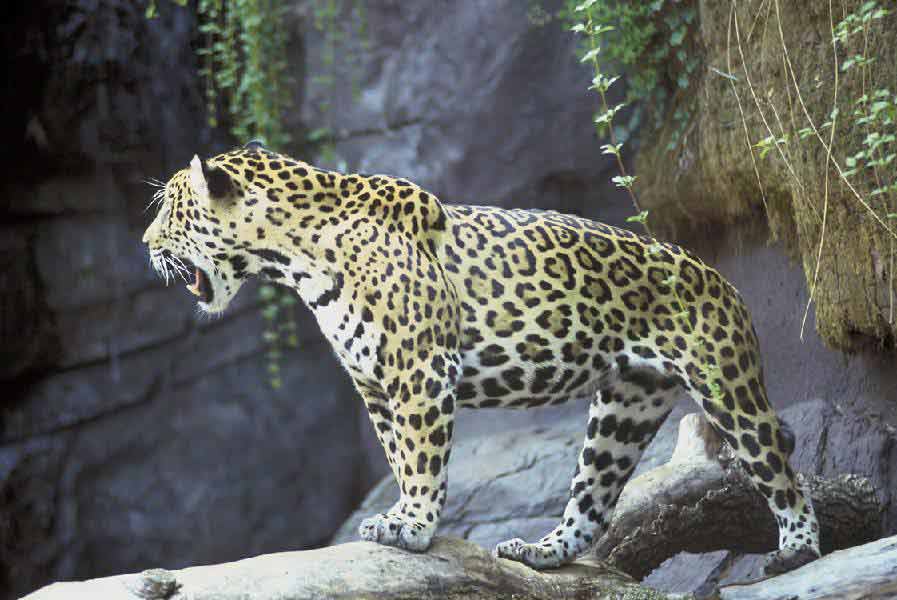 |
usa | world | animals | vocabulary | health | science | math | history |
Jaguar
The jaguar (Panthera onca) is a large member of the cat family native to South and Central America. It is closely related to the lion, tiger, and leopard of the Old World, and is the largest species of the cat family found in the Americas.
Jaguars vary from 1.1 to almost 1.9 metres in length, stand around 70 cm tall at the shoulder, and weigh between 57 and 113 kilograms. The jaguar has the strongest jaw structure of any feline. Although jaguars look very much like leopards and are closely related to them, their ecological role and behaviour is more similar to that of the tiger.

The jaguar's habitat ranges from the rain forests of South and Central America to more open country in Mexico, but they are rarely seen in mountainous regions. Known for their strong swimming and climbing abilities, they often prefer to live by rivers, in swamps, and in dense forest with thick cover for stalking prey. They are the largest predator in their range. Jaguars, on rare occasions, are seen as far north as the southwestern United States, particularly in Arizona. The historic jaguar range actually extended as far north as southern California and western Texas. Presently it is unclear whether these encounters reflect transitory or permanent populations.
Jaguars are solitary hunters that do not associate with one another outside the breeding season. They typically take large prey: their very strong jaw equips them to hunt deer, tapirs, and peccaries, but they are great opportunists and will take anything from frogs and mice to birds, fish, and domestic livestock. A jaguar will usually bite and pierce the skull of its prey, thereby killing it and demonstrating the strength of the jaguar's jaw muscles. A jaguar's bite can pierce the shell of a turtle (Emmons, 1987). Jaguars can run quite quickly, but do not have much endurance and rarely engage in long chases.
The background of the coat is usually an orange-yellow in colour, with numerous rings or rosettes on the flanks and spots on the head and neck. It is possible to distinguish this species from a leopard by the presence of spots inside its rosettes. A jaguar's rosettes are also larger than a leopard's. A condition known as melanism can create jaguars that appear entirely black (although the spots are still visible if one looks closely). These are known as black panthers, but do not form a separate species.

Young jaguar males reach sexual maturity at about three to four years of age, females about a year earlier. Females give birth to as many as four cubs after a 90 to 110 day gestation, but raise no more than two of them to adulthood. The young are born blind and can see after two weeks. They remain with their mother for up to two years before leaving to establish a territory for themselves, which can be anywhere between 25 and 150 square kilometres in size (depending on the availability of suitable prey). Typical lifespan is 10 or 11 years in the wild; in captivity, jaguars have lived up to 20 years.
The word jaguar comes from the South American Tupi-Guarani language. According to one early European explorer, jaguara meant "a beast that kills its prey with one bound." The original and complete indigenous name for the species is Jaguarete. Curiously, Jagua means "dog" in Guarani. Jaguar is also a royal title bestowed to a royal prince, princess or ruling monarch in some Maya traditions such is that of the Lencas. The jaguar's wide range means that it should not be in danger of extinction in the forseeable future. The species has declined in number in some areas, however, mainly due to habitat loss, especially in rain forests and grassland turned into cropland.
This article is licensed under the GNU Free Documentation License. It uses material from the Wikipedia article " jaguar".